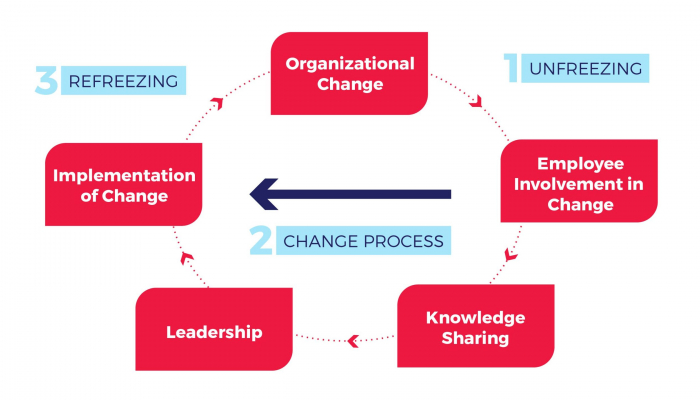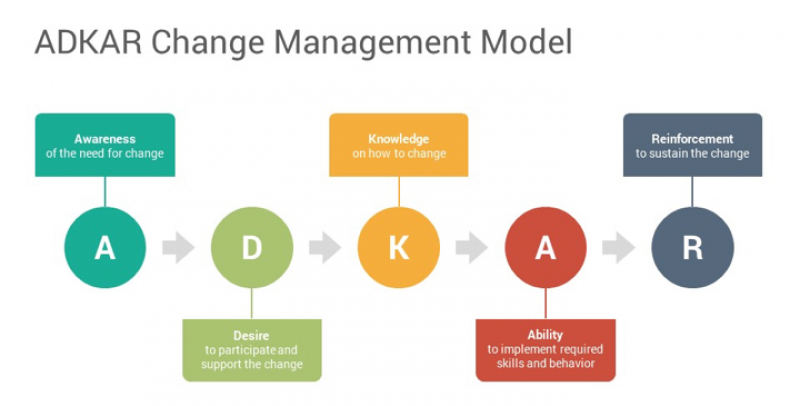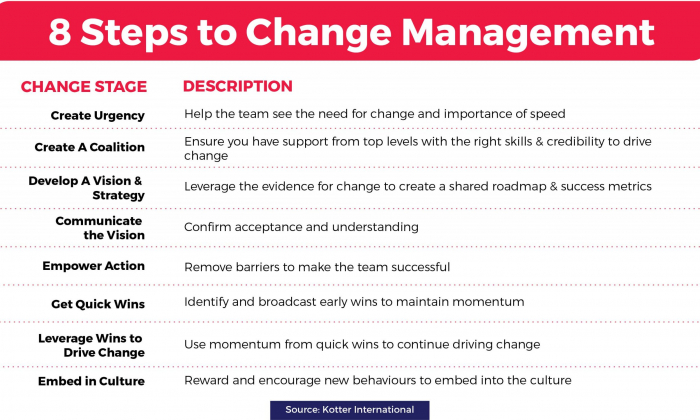Introduction
The pace of change in today’s world often has us reflecting on the 2,500 year-old maxim, “Change is the only constant in life.” Yet, despite this truth, how people adapt to change remains inconsistent at best.
Developing and deploying an effective change management strategy in your organization will allow you to mobilize employees and other stakeholders quickly and effectively.
There are a variety of approaches to change management, with some focusing on processes, systems and tools; others focus on the individuals leading and reacting to the change; while others focus on both aspects to varying degrees.
The three major change management models we’ll examine include:
- Kurt Lewin’s Three-Stage Change Management Process
- The ADKAR Model
- Eight-Step Process for Leading Change
The Three-Stage Change Management Process
German-American social psychologist Kurt Lewin was among the first to develop a simple, actionable model to address change management. His model involved three steps:
- Unfreezing: Think of it like a meal – you need to unfreeze it before you start cooking. The goal of this stage is to make people aware of the status quo and how it’s hurting the organization. Employees must see how change can be beneficial and prepare to accept the new process.
- Changing: This is where the change becomes real. Employees will begin to learn new processes, behaviours and ways of thinking. Employees must be reminded of the reasons for the change and how it will benefit them once fully implemented throughout this step.
- Refreezing: The final stage is all about reinforcing and solidifying the change. Employees must understand that the new process is the ‘new normal’ and must remain in place. Without this step, along with positive reinforcement, it would be easy for the organization to revert back to the old process.

Spotlight: Continental Airlines
 Lewin’s change model can be seen clearly in Continental Airlines evolution from poorest performing airline to airline of the year. Continental Airlines had a rocky history dating back to the 1980s when they filed for bankruptcy and were taken over by Texas Air Corp. After several failed mergers, Continental once again filed for bankruptcy in 1990.
Lewin’s change model can be seen clearly in Continental Airlines evolution from poorest performing airline to airline of the year. Continental Airlines had a rocky history dating back to the 1980s when they filed for bankruptcy and were taken over by Texas Air Corp. After several failed mergers, Continental once again filed for bankruptcy in 1990.
Gordon Bethune became the CEO of Continental Airlines and began his implementation of the change model with the unfreezing process; he focused on breaking the failing system while maintaining order. Bethune transitioned the company’s focus from cost-savings to putting out a quality product that reflected their customer’s expectations.
Next was the transition phase. Bethune offered rewards for company improvement. If Continental Airlines was rated among the top five airlines, staff would receive a $65 bonus, and if not, staff would receive nothing. This helped reinforce the idea that the company would succeed together, and fail together. Bethune was also known for his open-door policy and commitment to open communication.
Finally, Bethune moved on to re-freeze the organization making his changes permanent and successful, with respect to his ongoing and prevailing focus on the customers’ needs. For instance, Continental Airlines became America’s most on-time airline. Bethune and his employees focused on this objective each and every day, in order to achieve and sustain success. For Continental Airlines, change remained an ongoing process, however by re-freezing the organization, Bethune was able to create a sense of stability that made employees more comfortable and confident with the change process.
Applying the three-stage change management process to your organization
The three-stage change management model can be used by any organization. For instance, by unfreezing and identifying the most pressing issues, an organization can prioritize digital transformation as a key area of focus.
During the transition phase, an organization might engage all staff in discussions around how and when to implement a digital strategy. Staff will come together to brainstorm ideas and implement tactics focused on areas such as: exploring efficiencies created by embracing digital media, internal communications, and/or online fundraising. All staff will celebrate success and share in failures together. In fact, a common thematic of successful digital organizations is their ability to “fail fast”, learn and move on.
Once your organization has successfully implemented a digital change (as evidenced by; usage and utilization reports, employee feedback, performance improvements, etc.), you will create stability within your organization, thereby completing the refreezing stage. One example of stability could be clear and consistent job descriptions that take into account the expertise and commitment required to drive digital transformation. By re-freezing, you can inspire the confidence required to embark on the next desired change, which is always just around the corner.
Your organization must make every effort to institutionalize the changes that were successfully made by incorporating them into every aspect of your work, each and every day. You can accomplish this by creating a reward system, establishing feedback systems for your employees, and/or incorporating digital transformation initiatives into performance reviews. Ultimately, you need to ingrain the changes into your organizational culture to ensure long-term and sustainable success.
It is important to note that the three-stage change management process by no means implies that change is characterized by a beginning, middle and an end. Change and innovation go hand-in-hand, and “innovation excellence is not a linear process, but rather one that is the result of a multi-year effort peppered with changes in direction based on evolving insights and yes, even failure.”
Change management is iterative and constantly evolving to reflect environmental trends, new research, and the latest technologies. However, by adopting the three-stage change management process, your organization can approach change in a methodical and thoughtful manner, which will ultimately lay the foundation for ongoing and successful change management.
The ADKAR Model
Another popular approach to change management is ADKAR®, which stands for Awareness, Desire, Knowledge, Ability and Reinforcement. It contends that individuals, and consequently organizations, must progress through its five stages, in sequential order, to achieve and sustain change. ADKAR emphasizes the achievement of desired outcomes at each stage and enables individuals and organizations to measure their progress towards the outcome attainment.

Applying ADKAR to your organization
By adhering to the ADKAR model, your organization can manage change through thoughtful conversations, methodical processes and actionable steps.
For example, your organization can apply ADKAR to the implementation of a new software tool. Your organization can build ‘Awareness’ by communicating the need for the change. An organization can encourage ‘Desire’ amongst employees to support the change by highlighting how the new software is more cost-effective and time-efficient. An organization can lay the foundation for the ‘Knowledge’ component of the ADKAR model by drafting a plan that ensures all stakeholders are appropriately briefed on the new initiative. Next, ‘Action’ is required – and involves implementation of the plan. For example, your organization may choose to limit certain functionality within the software tool to one department at a time to ensure a smooth transition.
Finally, your organization can ‘Reinforce’ the importance of the new tool by building an internal taskforce to ensure that employees are maximizing its potential.
“Leadership teams that fail to plan for the human side of change often find themselves wondering why their best-laid plans go awry.” – PriceWaterHouse Coopers
8-Step Process for Leading Change
John Kotter developed the Eight-Step Process for Leading Change model and its updated companion, The Eight Step Process for Accelerating Change. The original eight sequential steps were outlined in Kotter’s 1996 book, Leading Change, to respond to factors Kotter’s research found that led to change management failures. Eighteen years later Kotter released the eight accelerators to respond to today’s accelerated pace of continuous change.

Spotlight: Creating a sense of urgency around digital transformation
As outlined in the diagram above, creating a sense of urgency is a necessary first step in implementing change according to John Kotter, and this can certainly be applied within the context of digital transformation. There are two ways to create a sense of urgency: one is to respond to a crisis, and the other is to inspire employees.
An example of a potential crisis would be a direct competitor focusing on digital transformation and effectively applying new technologies to successfully tap into a new demographic; their revamped model is now challenging your business model.
An example of inspiration would be a new initiative (grounded in digital transformation) that will set your organization apart from its competitors, and create meaningful impact. For instance, Cafédirect Producers’ Foundation (CPF) launched a campaign asking people to donate twitter followers, instead of cash. Their goal was to create a tweet so big that it could be auctioned for charity. So far, 8,152,186 followers have been donated making the tweet worth an estimated $122,282. New and innovative ideas like this can mobilize staff and reinforce the importance and potential of digital transformation in today’s charitable landscape. This type of “doses of market reality” activity has increased employee innovation and productivity.
In his book “A Sense of Urgency”, John Kotter highlighted four fundamental tactics to establish an atmosphere of urgency:
- Bring the outside in: A “we know best” culture reduces urgency; so help people see the value in external opportunities for themselves.
- Behave with urgency every day: Managers and leaders need to lead by example.
- Find opportunity in crises. Crises and opportunity are separate but interdependent components of transformation. Don’t be afraid to leverage a crisis to combat complacency with opportunity (e.g. the opportunity to apply innovation).
- Deal with NoNos: Don’t turn a blind eye to employees who are constantly hindering change – address them head-on.
Each of these four tactics can be applied to your organization to help create a sense of urgency, be it around achieving a fundraising goal, landing a new major donor, or retaining a corporate partner who is considering alternatives to the organization model.
The eight accelerators

How do these approaches result in effective change management to support digital transformation in an organizational context?
An effective change management process can guide your organization through the principal phases of digital transformation. An organization-wide, leader-led, long-term change management program can influence culture, business strategy and overall outcomes. This happens by:
- Creating the platforms for future visioning
- Establishing a variety of communications processes and channels that help build and sustain an innovative and empowered culture across departments; this includes non-hierarchical structures where multi-level input, collaboration and ownership of the change is encouraged and facilitated.
- Identify opportunities for improvement across the organization, for example; current versus future state technology (software and hardware), physical environment and human resource requirements such as redeployment, hiring for desired skill set, and fit.
Employee perceptions of change management in a multi-generational context
Employee perceptions of change management play a vital role in the success or failure of change models, and evidence suggests that employees from different generations adapt differently to change.
According to research regarding generational differences in the workforce: Generation x and y often view change, “as a vehicle for new opportunities” while millennials, “are simply accustomed to change and expect it in the workplace.”
Furthermore, a study published by EY (formerly Ernst & Young) finds that “Millennials are tech-savvy, but aren’t great team players. Gen X-ers are entrepreneurial-thinking, but rank low on executive presence. And last, but not least, Boomers are team players and loyal, but don’t adapt so well.”
While it is important to not to be constrained by these broad, age-based generalizations and to allow for exceptions to the research findings, potential approaches to managing change specific to each generation in the workforce are highlighted in the following table:
| Veterans 1922 – 1945 |
Boomers 1946 – 1964 |
Gen X 1965 – 1980 |
Millennials 1981 – 2000 |
|
|---|---|---|---|---|
| Stage 1: Awareness | Inform the business need for the change, providing background and facts | Discuss the business need for the change allowing opportunity for questions | Explain the business need for change, providing background and facts | Convey the personal and business benefits of the change |
| Stage 2: Understanding | Ensure resources and training are available to help people adapt to the change | Create shared meaning and convey common goals for the future after the change | Paint a picture of the future and describe the business goals after the change | Collaborate through discussion forums and open dialogue about the change |
| Stage 3: Acceptance | Reinforce the business need for the change and support | Encourage questions and respond objectively to challenges about the change | Involve people in exploring the impact and business benefits of the change | Coach, mentor, and provide immediate and ongoing feedback for the change |
| Stage 4: Alignment | Outline expected, organization goals, business results, and rewards | Build support for behaviour, organization goals, business results and rewards | Clarify expected behaviour, organization goals, business results, and rewards | Illustrate expected behaviour, organization goals, business results, and rewards |
| Stage 5: Commitment | Demonstrate common responsibility and accountability for the change | Foster buy-in, ownership and accountability for the change | Model desired behaviours to gain responsibility and accountability for the change | Support ongoing dialogue to build responsibility and accountability for the change |
Embarking on a Digital Transformation
Digital transformation requires thoughtful changes that extend beyond investing in the newest digital technologies. According to the World Economic Forum; companies will need to prioritize the following four areas of focus to become a successful digital enterprise:
1. Digital Business Models:
Companies need to change the way they identify, develop and launch new business ventures. “They need to build, buy, partner, invest and incubate/accelerate.” Organizations need to move away from long-term strategic plans, and instead make decisions more quickly with greater emphasis on decisions informed by data and analytics.
2. Digital Operating Models:
Developing technological capabilities is the first of many steps in a company’s digital transformation. Successfully identifying and implementing the most effective operating model will depend on other changes made, particularly with respect to strategy development and culture.
According to the World Economic Forum; “companies need to embrace a leaner organizational setup, moving away from traditional hierarchies to a flatter structure, with higher levels of employee empowerment enabling faster decision making and greater agility.”
3. Digital Talent and Skills:
Organizations need to focus on attracting, retaining and developing the right talent. It is critical that organizations create a digital culture and engage millennials in their workforce.
In order to be the employee of choice for millennials, organizations need to define their values based on their employees’ aspirations, empower and incentivize the workforce (through training and development opportunities), build workspaces that attract digital talent, and create policies that support collaboration and knowledge-sharing tools (ex. Facebook@work).
In order to create a workforce with digital skills, organizations are encouraged to assess the skills that are needed and develop training strategies accordingly, mine the organization for hidden talent, bring new skills into the organization by hiring digital leaders, and bring leadership (CEOs and Executive team members) into the digital age.
4. Digital Traction Metrics:
Organizations are finding that traditional key performance indicators (KPIs) are no longer effective at measuring the performance of a digital business, rather real-time data is the key to measuring and driving significant change.
What change management factors should your organization consider when preparing for digital transformation?
By exploring these questions, leadership teams can engage in a dialogue on their level of readiness. We’ll call it stage one:
- How much time do you have to introduce and roll out a change management plan? Some processes involve sequential phases that take considerable time and resources to coordinate and implement; others can be much smaller but equally effective when executed consistently.
- How large is your organization? The size and complexity of your organization will indicate whether a team, dedicated Project Manager, existing employee or a combination, would be best to drive the strategy to achieve results.
- How is your organization structured? While any organization can change its culture with the right support, certain organizational structures are more malleable than others and better able to transition. For example, organizations with decentralized management styles can more easily incorporate communication platforms necessary to support learning and sustaining the transformation over time. On the other side, organizations with more levels, centralized management and decision-making processes may need to invest more time and energy to achieve the desired outcome over a longer period of time.
- Does your organization function in a bureaucratic model with numerous policies, procedures and protocols? Or, does your organization follow a more flexible, entrepreneurial model? Do your employees regularly engage in cross-functional teams or work independently? Similarly, to management structure and style, how your employees work together —or not — can also affect the way they adapt to change as individuals and as teams. It’s important to consider your organization’s operational style and design your digital transformation strategy accordingly.
- Do members of your senior change leadership team possess the attributes (e.g. trust, credibility, etc.) associated with successful transformation? Title and position are not the only leadership factors to consider when establishing a transition team.
- Do you have a process for identifying your transformation champions? (e.g. exercises to identify change leaders within the organization) Executive Management can work together to identify individuals who possess the following qualities of a change leader:
- Commitment to a better way
- Courage to challenge existing power bases and norms
- Initiative to break through established boundaries
- Motivation of themselves and others
- Caring about how people are treated
- A sense of humour

Employees who embody these characteristics, and are passionate about their organization’s mission, should be engaged to lead change management initiatives. These individuals will drive innovation and move the organization forward.
- Is professional development a standing, occasional or non-existent part of your business model?
- How digitalized are your processes? What percentage of your work procedures require digital competency? Are these functions limited to certain individuals, teams or required across the organization?
- Are the reasons for your organization’s transformation clearly evident to your employees (e.g. Are they seeing significant changes in donor support? Have competing organizations dramatically changed their game plan?) Or, are they more subtle, necessitating a different approach to your digital transition rollout?
- What are your organization’s levels of employee satisfaction and engagement? Organizations that score higher in these areas will face less opposition to change than those with morale or other job satisfaction concerns. Examples of employee engagement and happiness surveys include:
- 15five – a software that facilitates weekly check-ins between employees and their managers by automatically sending a survey to all employees.
- Officevibe – this platform has been used by social sector clients to examine the impact of staff retreats on employee engagement. Officevibe also hosts a library of resources including; templates and guides to help managers initiate change based on employee feedback
- Culture Amp – another software provider that describes itself as “a people analytics platform that enables companies to truly understand what their people are thinking and feeling throughout the employee life cycle.”
- What types of social networks exist within your organization? How strong are they?
- Where do your employees fall in terms of change readiness?
- Do you have a process to measure your organization’s risk tolerance (i.e. Your organization’s willingness to accept or avoid risk)? An excellent resource is RIMS 2012 Executive Report entitled “Exploring Risk Appetite and Risk Tolerance”. This report defines and examines risk appetite, risk tolerance and risk culture.
Change Management Considerations
Unlike other transformations in the workplace (e.g. new leadership, downsizing, etc.) digital transformation is not restricted to the work environment. It is occurring all around, all the time. For the most part, individuals are pulled along regardless of any desire to maintain the status quo. Digital transformation has become the status quo and can no longer be viewed as a separate, external factor of our 21st century existence. As such, it can no longer be viewed as another milestone in the marketing plan to be achieved, celebrated and shelved.
Digital transformation can be considered as the foundational element of an organization’s marketing/donor retention and acquisition plan. It can also inform other planning individual processes, including communications, talent acquisition, and environmental services.
Food for thought:
- Build an organizational business plan focused on leveraging the digital space vs. an “IT strategy”. Digital transformation introduced at the business or corporate strategic planning level enables greater opportunity for widespread discussion, engagement and adoption across the organization. However, the presentation of digital transformation at this base planning level depends on the status of any existing plan(s) (e.g. If an organization is part-way through the implementation of a multi-year business or strategic plan, it might consider the introduction of digital transformation – perhaps as an enabler – as part of the plan progress review).
- Rethink your business development and marketing strategies: Many organizations tried and failed to view digital applications as add-ons to the organization’s broader development strategies. Consider the reverse: Create strategies for the “digital consumer” as the foundation for your planning.
- Strike inter-departmental project teams consisting of: Project lead / Executive Champion / Leader “Early Adopters” to oversee execution for the long term.
- Launch a “Digital Strategy” encompassing key components such as: Marketing, social media, branding, website and mobile, and analytics at all staff meetings and provide regular updates on progress at departmental and staff meetings.
- Empower individuals: Engage in “What’s In It For Me?” discussions; provide multiple opportunities for individuals to contribute suggestions and feedback inside and beyond their traditional reporting boundaries; introduce a “no blame” culture where innovation and experimentation aligned to the transformation are welcomed and encouraged;
- Celebrate early and often: Provide visible demonstrations of the organization’s commitment to digital transformation by way of regular progress updates from leadership, including high profile acknowledgements of team and individual efforts (e.g. certificate awards, team lunches, “super star” spotlights in communications vehicles); in addition to the use of existing communication channels, establish new, out-of-the-norm vehicles dedicated to celebrating transformation milestones (e.g. one organization introduced onsite ice cream truck visits to mark major milestones.
Summary
Change management doesn’t have to be hard. Determine the priorities for your business and then identify which model will work best to help you implement the desired change.
But most importantly, remember it’s a marathon – not a sprint, be patient and make that change a reality.